#palantiri
Text

Isildur and Anárion were borne away southwards, and at the last they brought their ships up the Great River Anduin, that flows out of Rhovanion into the western sea in the Bay of Belfalas; and they established a realm in those lands that were after called Gondor….
In Minas Ithil was the house of Isildur, and in Minas Anor the house of Anárion, but they shared the realm between them and their thrones were set side by side in the Great Hall of Osgiliath.
-J.R.R. Tolkien, Of the Rings of Power and the Third Age, The Silmarillion
The Life of Isildur: 3/10
#isildur#anarion#I had several concepts for this#but finally settled on the magic balls#on a three way call with dad I figure#tolkien#silmarillion#lotr#palantiri#gondor#lotr rop
55 notes
·
View notes
Text

The Watch Tower of Amon Sul
#tolkien legendarium#middle earth#the lord of the rings#tolkien#the fellowship of the ring#jrr tolkien#weathertop#watchtower#the watch tower of amon sul#elendil#palantiri#eriador#fortress of angmar#the witch king of angmar#angmar#witch king of angmar#nazgul#khamul#lotr#gil galad
17 notes
·
View notes
Text
#tolkien#unfinished tales#the lord of the rings#the hobbit#the quest of erebor#frodo#gandalf#saruman#ringwraiths#bilbo#thorin#druedain#palantiri#gondor#rohan#theodred
13 notes
·
View notes
Text
Maybe the 6 palantiri that are already inexplicably lost before leaving Númenor are merely being borrowed by Celeborn, who is rotating between them desperately trying to Facetime his missing wife
#more ROP shitposting#rop shitposting#the rings of power#rings of power#amazon lotr#numenor#palantiri#celeborn#galadriel#tolkienverse
52 notes
·
View notes
Text

Palantiri come in variable sizes. Baffling how they moved the big ones. Numenorean shown for scale.
I am very tired and sitting down and making this seemed a weirdly good idea.
14 notes
·
View notes
Text


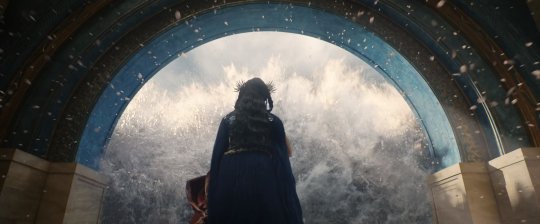
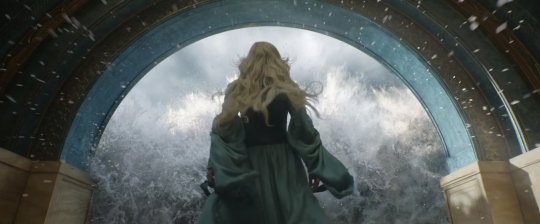
The Rings of Power, Episode 4: The great wave
#the parallel images that the Palantiri shows were incredible#best episode so far#the rings of power#the lord of the rings#tolkien#trop#lotr#m#Galadriel#Miriel
76 notes
·
View notes
Text

The Three Eowyns from my 1920s Middle Earth au, "A Dance at the Palantiri"!! The White Lady of Rohan, Dernhelm, and a flapper dancer!
aka the three personas of Eowyn that Faramir falls in love with simultaneously without realizing that they are all, in fact, the same person LOL
Fic Summary: It's the 1920s in Middle Earth, and Éowyn just wants to get away. Just for a week, to be able to truly be herself, not just an esteemed Princess of the Riddermark. When she escapes under the disguise of a man named Dernhelm to Osgiliath, by fate she crosses paths with Lord Faramir, an infamous playboy and partygoer, who manages to rope her into becoming a bartender at his equally, if not more, infamous club and bar, The Palantiri.
The Palantiri is more than meets the eye, same as its owner, however. Éowyn quickly realizes that the club is not just for people to lose themselves, but to lose their secrets too. There's more than meets the eye of Faramir, too, she finds.
Suddenly, Éowyn finds herself neck deep in a years old secret operation in the war effort, and must do so while keeping up the guise of a man.
Trying out and having fun with a different to my usual style "very stylized" style :D
Also should I update this fic?
#lotr#lotr fic#lotr fanart#lord of the rings fanart#lord of the rings fic#lotr au#modern lotr#kinda?#tolkien fanart#tolkien fic#lotr fanfic#lord of the rings fanfic#eowyn x faramir#faramir x eowyn#faramir/eowyn#faramir#eowyn of rohan#eowyn/faramir#my art#my writing#this style is SO much fun to work in!#Kinda wanna develop it more and implement it into my art more hmm#This fic's faramir: I'm an intelligence operative#ALSO THIS FIC's FARAMIR: I literally can't tell that these three people are the same person#hahahaha#(suspend your sense of disbelief ;) hehe)
90 notes
·
View notes
Text
My favorite arc in LotR is actually “Gandalf & Pippin’s Questions.”
The core of this relationship is that Pippin likes asking questions and Gandalf only sometimes has the leisure to answer them:
'What are you going to do then?' asked Pippin, undaunted by the wizard's bristling brows.
'Knock on the doors with your head, Peregrin Took,' said Gandalf. 'But if that does not shatter them, and I am allowed a little peace from foolish questions, I will seek for the opening words.'
(“Undaunted” is such a good word for Pippin re: Gandalf. He’s clearly never feared an authority figure in his life. Meanwhile, Gandalf is like “Pippin is a good kid but if someone doesn’t squelch him when necessary he’s going to do something REALLY stupid.”)
Later, the continuing saga of “Gandalf doesn’t like unnecessary questions” returns as soon as he does:
'Then Gandalf came back to us, and he seemed relieved, almost merry. He did say he was glad to see us, then.
’"But Gandalf," I cried, "where have you been? And have you seen the others?’
'"Wherever I have been, I am back," he answered in the genuine Gandalf manner. "Yes, I have seen some of the others. But news must wait."'
Note Pippin’s tolerant familiarity with “Gandalf giving useless answers.”
After Isengard and Pippin’s first sight of the palantir, we see its influence showing itself in Pippin’s stronger and angrier irritation at Gandalf's uncommunicative ways:
'You had the luck, Merry,' said Pippin softly, after a long pause. 'You were riding with Gandalf.'
'Well, what of it?'
'Did you get any news, any information out of him?'
'Yes, a good deal. More than usual. (...) But you can go with him tomorrow, if you think you can get more out of him--and if he'll let you.'
'Can I? Good! But he's close, isn't he? Not changed at all.'
'Oh yes, he is!' said Merry, waking up a little (...)
'Well, if Gandalf has changed at all, then he's closer than ever that's all,' Pippin argued.
We all know how that ends. Boy steals rock, boy looks into rock, boy gets his mind filleted by the Enemy, Gandalf evacuates with him to Minas Tirith.
But then! While Gandalf is quite clear that Pippin should have known better/talked to him before resorting to stealing (and he’s right, obviously), he also responds to this incident by changing his own behavior. He starts talking more.
'What did the men of old use [the palantiri] for?' asked Pippin, delighted and astonished at getting answers to so many questions, and wondering how long it would last.
And he seems to make it clear that this IS in response to the palantir incident, and is him attempting to take Pippin’s desire for information more seriously.
'But I should like to know--' Pippin began.
'Mercy!' cried Gandalf. 'If the giving of information is to be the cure of your inquisitiveness, I shall spend all the rest of my days in answering you. What more do you want to know?'
'The names of all the stars, and of all living things, and the whole history of Middle-earth and Over-heaven and of the Sundering Seas,' laughed Pippin. 'Of course! What less? But I am not in a hurry tonight. At the moment I was just wondering about the black shadow.'
(I love that Pippin laughs and says “If I have the option, I want to know everything, obviously,” partly because he’s making a joke so soon after that nightmare incident and partly because it’s the first time we see Pippin expressing a desire for real, comprehensive knowledge. Even if it’s a joke, this is also the point in the narrative where—having lost both Merry and Frodo—Pippin’s horizons start being forcibly widened, and we’re about to see him taking in an unfamiliar world by himself.)
Despite Gandalf’s “How much more do I have to say?” protest, Gandalf keeps talking and telling his passenger stories, even when Pippin’s falling asleep. <3
Pippin became drowsy again and paid little attention to Gandalf telling him of the customs of Gondor, and how the Lord of the City had beacons built on the tops of outlying hills along both borders of the great range, and maintained posts at these points where fresh horses were always in readiness to bear his errand-riders to Rohan in the North, or to Belfalas in the South.
After we get to Minas Tirith, they both have less time and less peace, but we still get a glimpse of Gandalf trying to balance Pippin’s questions with his other, weightier duties:
'There are evil days ahead. To sleep while we may!'
'But,' said Pippin.
'But what?' said Gandalf. 'Only one but will I allow tonight.'
(I don’t remember the exact question, but it was after they’d seen Faramir, and Pippin was disturbed by the fact that Frodo and Sam were traveling with Gollum. He wanted Gandalf to give an explanation, which Gandalf didn’t really have.)
Finally, two notes on the subject after the destruction of the Ring. Firstly, there’s this exchange when Frodo and Sam are first reunited with Merry and Pippin in their knightly armors:
'But I can see there's more tales to tell than ours.'
'There are indeed,' said Pippin turning toward him. 'And we'll begin telling them, as soon as this feast is ended. In the meantime you can try Gandalf. He's not as close as he used to be, though he laughs now more than he talks.'
And later in Minas Tirith (when Aragorn is keeping them around for his wedding, but he and Gandalf both refuse to tell them that’s why) Frodo teasingly recalls that line.
'Pippin,' said Frodo, 'didn't you say that Gandalf was less close than of old? He was weary of his labors then, I think. Now he is recovering.'
(Frodo, of course, also has a great deal of experience in “Gandalf not answering your questions even when he thinks he IS.”)
I don’t really have a point to this, I just love the shift in Gandalf & Pippin’s relationship over the course of the books, and I also love the change from Pippin’s sulky “if Gandalf has changed at all, then he's closer than ever >:/” to his merry, affectionate “He’s not as close now as he used to be, though he laughs now more than he talks.”
#tolkien#pippin took#gandalf#this has been in my drafts since last fall more or less but i'm still very fond of the concept being expressed#long post
1K notes
·
View notes
Text
Can we talk about the dragons some more?
I will be. Forever.
Many have already noted the care and detail that went into the design of each dragon, and I love watching the fall of Emon over and over to see new details each time.
But we also see so much of their personalities in this scene, and I love it so much?
Thordak is there to establish dominance, show his power, and accept worshipers, like a true red. He focuses on property damage (yes, people die, too, but that will happen when you nuke a mountain!) and showing off, because he wants lots of the ants in the city to survive. He needs their terrified adoration. We stan all of his "Is this your king?" speeches as he claims his throne.

Umbrasyl is doing what they've been told to do. As the least powerful of the remaining Conclave members, they are raining death from above but not overdoing it. Thordak has no domain and subjects if they melt it all. Bonus content fight between Umbrasyl and KimAllura. (P.S. they're not dead, guys!) I have a big soft spot for Umbrasyl, and I'm curious how much we will get to see the dynamic between the dragons as the story moves forward. They barely get along, and I hope we get to see them interacting with each other more. Something went down between them after Umbrasyl took over Gatshadow, and I want to know what it is that left the black dragon alone and stranded out there with busted palantiri.
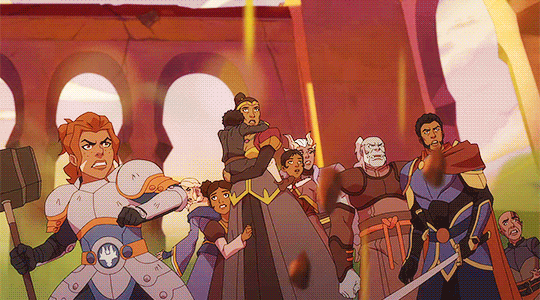
Vorugal, it's been mentioned, we don't see a lot of in the fall of Emon. But that's exactly as it should be. Think about it: Vorugal is an elite hunter. They live a solitary life, always seeking more challenging prey to indulge in their favourite pastime. What is the point of destroying a city of helpless ants to Vorugal? So they go for the most challenging targets first, i.e. Allura. I'm disappointed that we didn't get the iconic shot of Vorugal perched on the side of her tower before they destroy it, but at least Vorugal still destroyed it in this version. Then it's almost like they're searching the city for worthy prey, doing the bare minimum to satisfy Thordak's orders. Of course Vorugal tracks them to Greyskull Keep. VM are worthy targets for the white dragon. I'm sad we didn't get to see Vorugal wrestle Thordak for dominance there. That was such a fantastic scene in campaign. Hopefully we'll get to see the two of them butting heads in a different way later on.

And Raishan, clever little pixie. She's just having fun with it. You see her casually flying around the city, blowing smoke here and there before she eats Scanlan's biggest fan. But she knows what she's doing. She killed Uriel with her first attack, and after that she's pretty much like a cat. What can I do that will satisfy Thordak's command but is the most amusing to me? Playing with VM, for one. She makes sure they know who she is, and that she knows who they are. After that, she's going to do what a green dragon does: be sneaky and infiltrate their keep even before they flee to Whitestone. She was a lot more subtle about it in campaign than she is about it here, but we want new viewers to feel like they've spotted something hidden, too (LARKIN WATCH!). Good job. Raishan was the first to give her name during the attack in the campaign, and of course she gave it to us here in the fall of Emon as well. We stan a queen. You'd better put some respect on her name.
Really looking forward to seeing more of her--and all the dragons--this season. Even if they just do cut-aways to their territory or Pike has dream sequences to show what's going on with them, I'll take it. We deserve more than just their death scenes. They are legendary villains and deserve as much love as the Briarwoods.

#the legend of vox machina#dragons#raishan#thordak#umbrasyl#vorugal#lovm#lovm season 2#legend of vox machina#tlovm#lovm spoilers#vox machina spoilers#tlovm s2#tlovm season 2
224 notes
·
View notes
Text
Arvedui's death by drowning in Forochel is actually very unfair because he follows all the Tolkien Fantasy Rules(TM) and then dies because, nope! This time, real-life rules applied!
Arvedui, king of Arthedain (part of Arnor), was a Man, and he listened to the elves, which is generally a good idea in Tolkien's world! What's more, he listened to Cirdan('s people), which is literally always a good idea in Tolkien's world except for this one time.
Yes, the Lossoth locals warn him about sailing in such dangerous, icy conditions, but these are Cirdan's highly experienced elven mariners on elven ships who, after all, arrived here safely. And Arvedui is urgently needed back with his people to fight the Witch-king of (quite literally at this point) Angmar.
But no! Fantasy rules are out for five minutes and real-life rules are in, and Arvedui drowns (along other people and two palantiri), the last king of Arthedain.
#arvedui's kind of a jerk because of the whole#claiming to rule gondor because he married firiel thing#like why can't she rule it? or what's wrong with co-monarchs?#but I still think his death is unfair#lotr appendices#lotr#lord of the rings#the silmarillion#tolkien#arvedui#arthedain#arnor#lossoth#forochel#cirdan#softlysilver#palantir
31 notes
·
View notes
Note
Hello. As a watcher of a few drama series as well as a reader, I like how you noticed Easter eggs from season 1. Me personally, I follow character development as well as Easter eggs. (Not saying you don't.) For example, following Disa's development in season 1, one can conclude that she is a character who will fall under Sauron's influence going forward, which also, reinforces lore regarding the dwarves and hoarding. Interesting how the showrunners reinforce that she will get corrupted.
I want to add that if I go by Easter eggs alone and ignore character development, Bronwyn will be under his influence, as celebrimbor and Galadriel were, and Ar-Pharazon. However, since they will all know who he is this season, based on her character development, and not just Easter eggs, when she learns who he is, I see her leading a faction against him. Also she isn't in the lore so I wonder how much she will be a focus going forward, whereas Disa might be more likely effected.
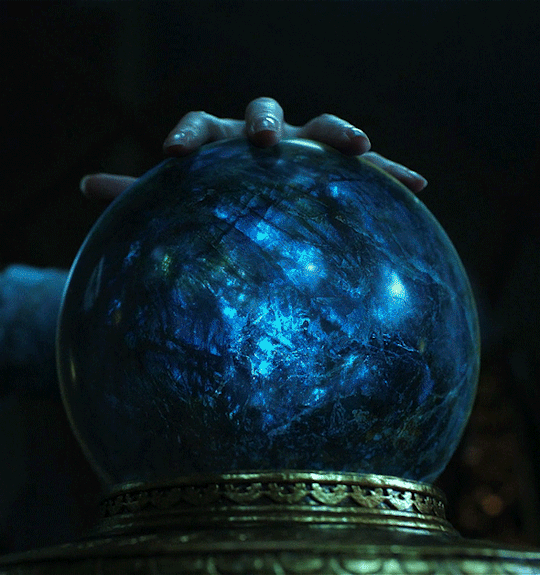
I agree! And you bring up a very interesting topic.
I love how we can predict each character's story arc and development. The potential (and assured) tragedies and triumphs make for an enriching analytical experience. It often saddens me that not all of the characters we love will have happy endings. For example, you have beloved characters like Isildur, who dies tragically, being ensnared by the Ring. We know how vulnerable Eärien is to certain influences, so her looking into the Palantir in episode 8 does not bode well, considering Sauron can communicate through Palantiri. Theo also has an extremely dismal path ahead of him.
The Stranger is a little less predictable, and we might think it's obvious that he'll end up being good (he probably will), but there are a few indications in interviews that it's not set in stone yet, despite him saying, "I am good."
So, in Season 1 alone, every character has a pretty solid foundation from which we can predict the direction of their development, and it's really fun to talk about. You brought up Bronwyn and Disa, so let's talk a bit about them.

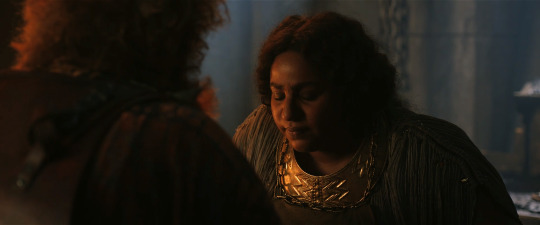
-------------------------------
Finrod's metaphor is the template we can use to determine the ending of an arc.

"Do you know why a ship floats, and a stone cannot? Because the stone sees only downward. The darkness of the water is vast and irresistible. The ship feels the darkness, as well, striving moment by moment to master her and pull her under. But the ship has a secret. For, unlike the stone, her gaze is not downward, but up, fixed upon the light that guides her, whispering of grander things than Darkness ever knew."
(TROP: A Shadow of the Past)
This was used even for Gollum, whose ending was nigh certain from the beginning, although he was technically redeemable.
"He was interested in roots and beginnings; he dived into deep pools; he burrowed under trees and growing plants; he tunnelled into green mounds; and he ceased to look up at the hill-tops, or the leaves of trees, or the flowers opening in the air: his head and his eyes were downward."
(FOTR: The Shadow of the Past)
-------------------------------
DISA
There's a lot here. I agree that she will be deceived by Sauron. I love her, but she is walking a very tight rope.
It is difficult to drive the point home without talking extensively about mithril, but I am in the middle of explaining all of the mithril stuff on my blog, so my thinking will be exposed soon.
Sauron can plant certain words in the mind, so that the speakers believe it came from their own thoughts. For example, Isildur, Gollum, and Bilbo independently describe the One Ring as being "Precious." Celebrimbor talks about "the key that unlocked the dam," "power over flesh," and a "power of the unseen world," without knowing that those are Sauron's words. Then, he continues to use words that Sauron has used before (as he fidgets with the mithril).

(1x08):
Galadriel: "Those words. 'Power over flesh.' Where did you hear them?"
Celebrimbor: "I... I was conferring with my smiths, I think. I... No, I believe those are my words."
G: "Was Halbrand with you?"
C: "What's it matter? It's over."
(1x02):
Galadriel: "Your home. Where was it?"
Sauron: "What's it matter? It's ashes now."
So, when Elrond turns to Disa and says...
"Go towards goodness."
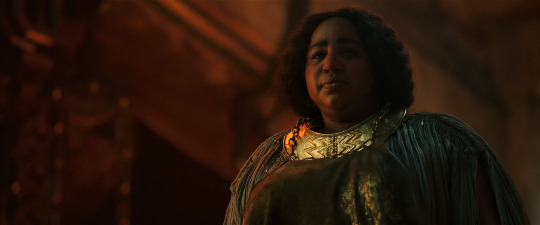
...we are left with a very important question:
Will she?
Depends. Is her gaze up or down? Is she whispering the same things that Darkness whispers, or is she "whispering of grander things than Darkness ever knew?"
In episode 7, her true motivations are brought to light. She's not evil, but she is treading some dangerous territory. After Dúrin says that he failed Elrond, and it's his fault that the Elves must flee, Disa gives a very unnerving monologue:
"No. No, it isn't. [...] It's your father's. He's grown too old, too suspicious, his mind too feeble, his eyes too dim to see that no matter how many crests he hurls to the floor, one day this will be your kingdom—Dúrin IV's. Not your brother's. Not some other Dwarf-lord's. Yours. And mine. And together, we will rule this mountain and all others before our time is done."
Pause.
Now, I don't know about you, but that just raises a ton of exclamation points in my head. Do the highlighted words sound familiar?
"Against your enemy. And mine."
"Together, we can save this Middle-earth." ["Save, or rule?"]
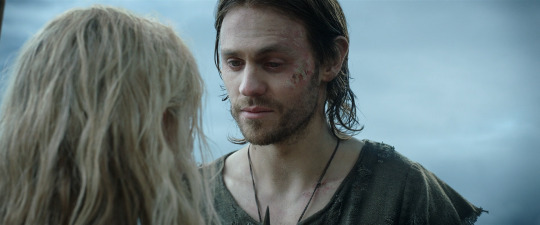
Disa is so intent on gathering mithril, that she doesn't recognize the nature of what she's saying.
She seems to genuinely care about Elrond, and the idea that he and his people will become extinct if they don't leave Middle-earth is probably distressing, especially since the Dwarves have a supposed means of saving them, and Dúrin III isn't helping.
However.
In retrospect, the apparent dependency the Elves have on mithril seems almost like an excuse for her.
Disa: "Lice-bearded, uncaring, old fool!"
Dúrin: "What if he's right?"
Disa: "You're not thinking of letting this happen!"
Dúrin: "What choice do we have?"
Disa: "You said the other Dwarf-lords were open to the proposal. If we reopen the mine ourselves, prove to them there's a safe way to gather mithril, perhaps they'd make him listen. Perhaps we could force your father's hand" (1x07).
She never mentions Elrond, or the Elves.
Also, who really likes to use Force?
"But he ruled rather by force and fear, if they might avail"
(The Silmarillion: Of the Rings of Power and the Third Age).
"Supposing that's the trouble. Supposing we've been using too much force" (1x08).
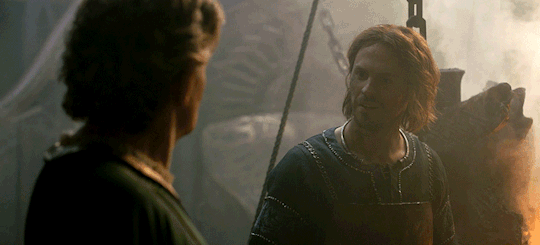
But what connection could she possibly have to mithril? Why does she want it so badly?
She was the first one to find it. In episode 4, Dúrin tells Elrond, "Disa detected it during a routine gold-seaming."
The remainder of her monologue is the most revealing.
"That mithril belongs to us—to you and me. And together, one day, we are going to dig."
Keep in mind that Elrond has just been cast out of Khazad-dûm, and Dúrin and Disa believe there is no stopping the Elves from leaving Middle-earth. The only race they are concerned about now is the Dwarves. Yet, Disa is still set on obtaining mithril, and she no longer has the excuse that it's to save the entire Elven race. She emphasizes "to you and me," as if to say, "Forget the Elves. Now, it's ours."
All of this sets Disa up to be extremely vulnerable to Sauron's intriguing suggestions, if/when he comes to Khazad-dûm. I think we can compare her to Celebrimbor in a lot of ways. She's a smith, like Celebrimbor (and Sauron), and wants to make the Dwarven people prosper. But excessive ambition can lead to pride, and...
"Humility has saved entire kingdoms the proud have all but led to ruin" (Galadriel, 1x06).
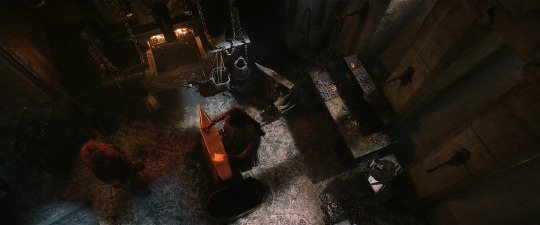

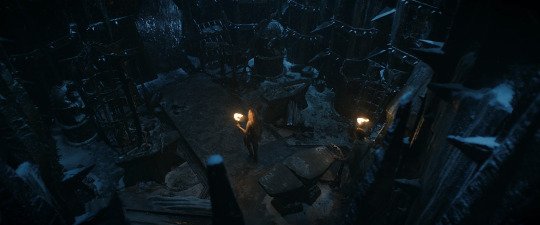
-------------------------------
BRONWYN
We can end on a happy note.
Like Disa, Bronwyn can also be compared to Celebrimbor in some ways. Celebrimbor is an artificer, who wants to bring beauty to Middle-earth, and Bronwyn is a healer (which is what Sauron claims he wants to be). However, she is much more humble, with little ambition but for the welfare of her son and neighbors. She also has Arondir to help her in moments of despair, like in episode 5.

This season, she seemed to be very defensive of Halbrand, understandably so. Leading the Men of the Southlands was "a burden [she] never sought to take up," so having the Promised King finally appear was a tremendous relief. She did everything she could to heal his wound in episode 7 and asked Galadriel what to do with him when it continued to fester. She did not hesitate to gather provisions for the ride to Eregion, and was the first to say, "Strength to the King."

But despite her fidelity to Sauron's kingly guise, I think we can be assured that she will perceive the peril sooner or later. Let's repeat the same question as before:
Will she go towards goodness?
Depends. Is her gaze up or down? Is she whispering the same things that Darkness whispers, or is she "whispering of grander things than Darkness ever knew?"
Answer:
Theo: "Do you remember when I was little, when I used to have bad dreams?"
Bronwyn: "I remember."
Theo: "Do you remember what you used to say, when you would hold me in the dark?"
Bronwyn: [nods]
Theo: "Would you say it to me, now?"
Bronwyn: "In the end, this shadow is but a small and passing thing. There is light and high beauty, forever beyond its reach. Find the light, and the shadow will not find you" (1x06).
By the time everyone knows who Sauron is (after the One Ring is forged), I can picture a dynamic like the one in Númenor between the Faithful and the Kingsmen. Bronwyn and Arondir's standing might be similar to Míriel and Elendil's. Judging by this scary piece of foreshadowing, Sauron will probably try to seduce Bronwyn in some manner. Charlie knew what he was doing when he made this face:

(note Arondir and Galadriel looming in the background lol)
Arondir would obviously NOT be too happy about that, and in episode 7, we can already see many hints of his distrust. Considering that Sauron injured himself with a wound that needed Elvish medicine (which probably required some sorcery), I wonder if Arondir witnessed something. (I can make another post on this, later.)
In any case, I don't think Bronwyn will be 'conquered.'

The lyrics of Plea to the Rocks solidly point towards where her arc is going.
Amanya fírië, alcarinquë-anyalie
Nolwa mahtar
Koivierya queluva rië aurenna quel-kala
Laure
Envinyataina Órerya siluva elerrína
Kardalyaron minty-oialë
Blessed death, glorious memory
Brave soldier
Her life will fade only upon the day light fades
Golden light
Renewed, her heart will shine, crowned with stars
Deed of your people, remembered forever
Her death will probably be like Morwen's (Túrin's mother), in The Silmarillion:
"But Morwen said: 'Almost. I am spent. I shall go with the sun. [...]' But Húrin did not answer, and they sat beside the stone, and did not speak again; and when the sun went down Morwen sighed and clasped his hand, and was still; and Húrin knew that she had died. He looked down at her in the twilight and it seemed to him that the lines of grief and cruel hardship were smoothed away. 'She was not conquered,' he said; and he closed her eyes, and sat unmoving beside her as the night drew down" (Of the Ruin of Doriath).
#rings of power#trop meta#rop meta#rop analysis#sauron#bronwyn#disa#answers from the palantir#silmarillion#book quote#morwen#halbrand#galadriel#arondir#celebrimbor#mygifs#myedit#finrod#character development#anonymous asks#the fellowship of the ring
24 notes
·
View notes
Text

Forochel
#tolkien legendarium#middle earth#the lord of the rings#jrr tolkien#forochel#lossoth#palantiri#arvedui#arthedain
9 notes
·
View notes
Text
Elves all had magical abilities. They were not just all equal in talent, like us humans, and they didn't have all the same level of learning. The Eldar, those who went to Aman, were instructed in "skill" directly by the Valar, so they were much more learned. Also, those who had seen the Light of the Trees were deemed more powerful only by that fact:
Great power Melian lent to Thingol, who was himself great among the Eldar, for him alone had seen with his own eyes the Trees in the days of their flowering and King though he was of Úmanyar, he was not accounted among the Moriquendi, but with the elves of the light, mighty upon Middle-Earth. (The Silmarillion, "Of Thingol and Melian" )
This implies that only seeing the Trees gave magical power.
Galadriel is also from that category, being a specially gifted and strong-minded Ñoldo who had seen the Trees. Elrond from his part is not a real Eldar because he never went to Aman, but he was from great lineage and had been raised by high Elves, so he had much knowledge and much wisdom, but not on par with Galadriel.
In LotR, she is the only Elven ruler remaining to have seen Aman, and I don't remember any other Elf mentioned in the story to have seen Aman.
Galadriel is one of the last of an ancient people called the Ñoldor still living in Middle Earth. The history of the Ñoldor is the subject of the majority of the Silmarillion and, while Galadriel comes into it only briefly, the achievements of the Ñoldor can give us some insight into Galadriel's influence and power.
Power
I've noticed that in the following, I talk about this nebulous term "power" quite often; let's spend a little time defining that.
In Tolkien's world, there are two 'layers' of reality, the primary world, and the secondary world. The secondary world is what Aragorn ( in the films ) meant when he said
"He's passing into the shadow world. He'll soon become a wraith, like them".
Elves, wraiths, and other supernatural creatures dwell largely in this secondary world, and this is where most of their power lies. It's the world that Frodo saw when he was dying from the stab wound from the Nazgûl blade, that's why Arwen appeared to glow when he looked at her. In the books, it's described thus:
With his last failing senses Frodo heard cries, and it seemed to him that he saw, beyond the Riders that hesitated on the shore, a shining figure of white light; and behind it ran small shadowy forms waving flames, that flared red in the grey mist that was falling over the world.
The shining figure is the Elf-lord Glorfindel; the shadowy ones are Aragorn and the hobbits. It seems that fire also exists strongly in the secondary world, which is why the Nazgûl fear it.
This Power takes many forms, but in general it can be seen as the ability to shape the world to your will in some way or another. This may mean great skill at making things, or enormous charisma, or great physical strength; or, in some cases, all of them at once.
The Ñoldor
The Ñoldor were perhaps the most powerful people ever to walk Middle-earth. The Silmarillion, the great history that underlies the Lord of the Rings, is largely an account of their deeds and their history. To give you an idea of what they could accomplish:
The palantiri, the seeing-stones, were crafted by the Ñoldor; Gandalf speculated that they were made by Fëanor, the greatest craftsman who has ever lived. Fëanor was Galadriel's half-uncle ( that is, her father was Fëanor's half-brother ).
Thorin's sword Orcrist was forged by Noldor smiths.
Gandalf's sword Glamdring, which he used to fight the balrog and throughout LotR, was also made by Ñoldor smiths.
Frodo's sword Sting was a trifling example of the craft, but was made by the Ñoldor.
The Rings of Power, including the Nine Rings of the Nazgûl, the Seven rings of the Dwarves, and the Three of the Elves, were all made by the Ñoldor, though with the help of Sauron.
Rivendell was among the last realms where Ñoldor could be found in significant numbers.
The Ñoldor are, in short, a Big Deal. Galadriel is accounted one of their leaders.
Galadriel's History
Living in Valinor
In brief, the first of the Elves who awoke on Middle-earth were persuaded to travel into the West and live with the Valar, effectively the gods of Middle-Earth. Some Elves grew tired or afraid on the journey west and remained in Middle Earth, but most made the journey all the way to the land of the Valar. They were divided into three groups or tribes: the Vanyar, the Ñoldor, and the Teleri.
In Valinor, the Elves reached the pinnacle of their abilities. Galadriel was born during this time, the granddaughter of the King of the Ñoldor.
Leaving Valinor
In time, Melkor, the first Dark Lord, and Sauron's old boss, planted suspicion in the hearts of the Ñoldor, making them think that they were being imprisoned in Valinor. Galadriel's half-uncle Fëanor, eventually led a large portion of the Ñoldor to leave Valinor in pursuit of Melkor. Galadriel went with them, and we hear that:
Galadriel, the only woman of the Ñoldor to stand that day tall and valiant among the contending princes, was eager to be gone... the words of Fëanor concerning Middle-earth had kindled in her heart, for she yearned to see the wide unguarded lands and to rule there a realm of her own will.
Galadriel through the Three Ages
The First Age
At length the Ñoldor came to Middle-earth, drove back the servants of Melkor ( now renamed Morgoth ), and established their own realms. The Ñoldor were noted as being stronger, wiser, more skillful, and more powerful than the Elves who had remained in Middle-earth.
This was the time that the power of the Elves was at its height, the heroic age when legends were made. Galadriel remains the only woman mentioned as a leader of the Elves in this time.
Near the end of the First Age, the Ñoldor kingdoms were overrun by Morgoth, and many of their leaders were killed.
The Second Age
At the end of the First Age, the western lands where the Elves had settled were largely destroyed by the war between the Valar and Morgoth. Most of the leaders of the Ñoldor were already dead; many of the Elves now chose to leave Middle-earth and return to Valinor. Galadriel, however, took a portion of the Ñoldor east, and with her husband Celeborn founded the Elven kingdom of Eregion.
Eregion was the last great kingdom of the Ñoldor. Here the Rings of Power were forged, though Galadriel distrusted the being who called himself Annatar and taught them to make Rings. Her distrust was well-placed, since Annatar was Sauron.
Eventually, Galadriel left Eregion to take up the rule of Lothlórien; and there she remained, until the time of Lord of the Rings.
That, then, is the short version of Galadriel's history. Her great power and wisdom come from her history, being born in heaven and having lived through the greatest legends of Middle-earth. She's older than any other leader in Lord of the Rings or the Hobbit ( except for Cirdan, the shipwright, but he never does much ). She is in many ways a relic of a bygone age, a memory of what the Elves could do at their peak.
The Ring
Galadriel bears one of the Three, the pure rings that the Elves made without Sauron's personal help. The power of the Three is to preserve and remember, so it is likely that the ring helps her maintain her native power, keeping her at her peak.
Sauron
Sauron is a Maia, one of the servants of the Valar. He is a being far beyond any elf or human, an angelic spirit that once helped to build Middle-earth in the very beginning. He has by this time lost much of his native power, pouring a lot of it into the ring, squandering more in creating servants, but he is still formidable. The Valar forbade any of their people from fighting Sauron directly, since last time they tried something like that it destroyed a continent.
All things considered, the banishment of Sauron from Dol Guldur was a great achievement for any individual ( while it's true, as comments have pointed out, that Sauron planned to flee and return to Mordor, he also most likely could not have withstood Galadriel if he wanted to ); Galadriel is one of the few who could possibly have driven him out.
4 notes
·
View notes
Text

I wonder if Galadriel seeing the great wave destroying Númenor through the Palantir would at all be foreshadowing for future seasons of Rings of Power for herself directly?
Would that be interesting divergence for Galadriel to actually be IN Númenor during the Akallabêth? I know this is unlikely but we have no idea what Galadriel will really be doing in later seasons. In the books Tolkien couldn't make up his mind and then doesn't mention her at all really in the War of the Last Alliance.
Could her hunt for Sauron lead her to chasing him to Númenor?
In the Palanatir scene we hear:
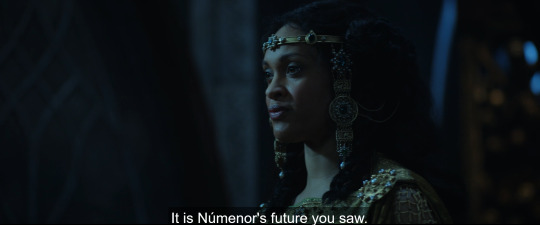
Tar-Miriel: It is Númenor 's future you saw
Galadriel: Palantiri show many visions. Some that will never come to pass.
Tar-Miriel: It has already come to pass. The vision begins with your arrival

Clearly Galadriel's arrival is connected with the vision of Númenor 's downfall and that's nowhere in the books but makes a nice connection of Galadriel to Númenor fate. We assume ROP will depict the downfall of Númenor and not give them a happy ending, so would Galadriel be tied up in that?
If she is there during the downfall. How could she be saved? A Great Eagle? Another raft?
#galadriel#rop#rings of power#the rings of power#rop predictions#numenor#speculation#miriel#queen-regent miriel#rop meta#meta
12 notes
·
View notes
Text
Seasonal theme: Magical summer (ending)
This summer will be a season of wonders and enchantments, of spells and wizards - a magical summer!
Here is a list of beings, entities, objects and concepts you can check out if you want to add some magic to your summer:
In fiction (but isn’t fiction a myth-to-be?)
Shakespeare’s work greatly influenced the world’s vision of witches and wizards, be it through the Weird Sisters/Three Witches in Macbeth, or Prospero in The Tempest.
The Sorcerer’s Apprentice is one of the most famous pieces of “wizard fiction”. Starting out as a German poem by Goethe, adapted from a world-wide folktale, it then became a French “symphonic poem” in the hands of Paul Dukas. Disney then adapted this symphonic poem into a world-famous animated short in their movie Fantasia 2000, before re-adapting the poem into a completely unrelate teenage-urban fantasy movie in 2010. A urban fantasy movie not to be confused with another kid-friendly fantasy movie inspired by the poem of Goethe and sharing the same name (as well as plot elements, such as Arthurian sorcerers finding themselves in the present-day world). This time it is a British “The Sorcerer’s Apprentice”, released in 2001.
The depiction of Merlin in The Sword in the Stone, both the Disney movie of the 60s and the novel by T. H. White that inspired it, also had a great impact on the vision of the character in popular culture. Both works also contain a famous fictional witch in the person of Madame Mim. A warning, however: Madame Mim only appears in the first editions/first version of the novel, on which the Disney movie was based. In the 50s White rewrote his novel, and excluded the chapter of Madame Mim. Madame Mim in the novel is also very different from the character Disney made her out to be.
A last creation of Disney for this list: Flora, Fauna and Merryweather, the three good fairies (and actual heroes) of Disney’s Sleeping Beauty.
The Wicked Witch of the West is one of the most famous depictions of a “wicked witch” in the mediatic landscape - and in fact, many witch depictions today are still inspired by her (most notably the green skin or the fact of being melted by water). I am of course here referring to the Wicked Witch as she appears in the MGM movie The Wizard of Oz - this Witch being a very different character from the Wicked Witch of the West appearing in the original novel by L. Frank Baum, The Wonderful Wizard of Oz. Not that Baum did not create quite a lot of very famous witches: I can mention Mombi, the antagonist of the second Oz book, The Marvelous Land of Oz, or the Good Witch of the North and her counterpart Glinda the Good, the Sorceress of the South. These two are quite notorious as being the first “good witches” to ever appear in American literature.
In Tolkien’s Legendarium (The Hobbit, The Lord of the Rings, the Silmarillion): Gandalf the Grey, Saruman the White and the Rings of Power - especially the One Ring. All became archetypes of the fantasy literature and unchallenged character-types (or artefact-types) in all future high fantasy/epic fantasy sagas. Plus - I almost forgot - the palantiri, the “seeing-stones”, Tolkien’s own spin on the classical “crystal ball”.
Other wizards of fantasy classics would include Belgarath the sorcerer and his daughter Polgara, from David Eddings’ (and his wife) The Belgariad, a duo purposefully designed to play fully while subverting in many ways the “Gandalf-type of character” ; as well as Ningauble of the Seven Eyes and Sheelba of the Eyeless Face, the alien and otherwordly patron-warlocks of Fritz Leiber’s iconic heroic duo, Fafhrd and the Gray Mouser.
The magic-users of sir Terry Pratchett’s Discworld deserve an entire section of their own. Each one of them is a careful parody or caricature of the wizard or the witch as envisioned and imagined by fantasy literature, witch-hunters or New Age hippies, as well as a reconstruction of these same stereotypes and cliches, based on philosophical, humanist and scientific principles, making them as much realistic takes as bloody hilarious incarnation of the “witch” and “wizard” character types. For the wizards you have Rincewind (with the Luggage, of course), Mustrum Ridcully, Ponder Stibbons or the Unseen University (a wizard school long before Harry Potter existed). For the witches you have Granny Weatherwax, Nanny Ogg, Magrat Garlick or Tiffany Aching. And let’s not forget the gender-challenging Eskarina...
Speaking of Harry Potter - despite the controversies surrounding its creator, the Harry Potter book series, and the movie series that followed, is a franchise that cannot be ignored when considering the image and perception of witches, wizards and magic in fantasy. The titular character of Harry Potter deeply marked the minds - as much as his two friends/co-protagonists, Ron Weasley and Hermione Granger, his nemesis Draco Malfoy, his mentor/school headmaster Albus Dumbledore, the magic school of Hogswart itself, or the magical sport known as Quidditch.
However, while Harry Potter cannot be ignored, it also must not be forgotten that this franchise was the last of a long set of series depicting children trying to learn magic in a school for witches or wizards, such as Wizard’s Hall by Jane Yolen, The Circle of Magic by MacDonald and Doyle*, Anthony Horowitz’s Groosham Grange (plus its sequel “The Unholy Grail”), and of course Jill Murphy’s The Worst Witch. Special mention for Neil Gaiman’s The Books of Magic, which do not feature a magic school, but are about a young British boy looking a lot like Harry Potter and training to become the greatest wizard of his era - and that despite being a story released seven years before Harry Potter. [* Again, to avoid confusion, this series is not the same as Tamora Pierce’s Circle of Magic, which ALSO deals with young wizards learning to control their powers - but this time was released in parallel to the Harry Potter series].
In a similar way, Harry Potter himself is the last of a long “bloodline” (inkline? Since they’re literary character) of fantasy series-protagonist that start out as young teenagers or kids, become sorcerer apprentice or wizards in training, and grow to be famous and heroic figures of the world of magic. Before Harry there was Pug, of the Riftwar Saga (later expanded into the Riftwar Cycle), and before Pug there was Ged from the Earthsea series.
While I do not usually include in those list too-recent works, because I brought up Harry Potter I am in the obligation to mention two big recent successes. On one side, the Japanese anime Mashle: Magic and Muscles, which is a very funny parody of the Harry Potter world, if it met the tropes and characters typical of recent seinen superhero mangas, such as One-Punch Man or My Hero Academia. On the other side, the American cartoon The Owl House, which gently mocks the problems inherent to the Harry Potter franchise, while offering its own alternate plotline about a teenager trying to learn magic in a world divided between “regular” humans and magical witches, only to be confronted with great evil powers beyond what she could imagine...
Two very different dreaded witches: on one side, The Lady from The Black Company, wife and former co-ruler of the dreaded sorcerous overlord The Dominator, and absolute mistress of the Ten Who Were Taken, vile wizards including some terrifying folks such as Soulcatcher, Shapeshifter, The Limper, The Howler or the Hanged Man... On the other, the witch-queen of Neil Gaiman’s Stardust, one of the three Lilim sisters of a fairy-land beyond a certain Wall... She was reinvented as the witch Lamia in the movie adaptation of the novel. I will also throw in another dreaded female magical entity invented by Neil Gaiman: The Other Mother, from Coraline - who is, after all, at one point called a “beldam”...
Not a book, not a movie, but a card game! The card game Magic: The Gathering deserves a mention, being one of the first and most famous collectable strategy card games, long before Japan overtook with the world with Yu-Gi-Oh, Duel Master and co. The original concept for the game was that each player embodied a wizard fighting another wizard, eac card being a different spell/magical artefact/summoned entity, and each deck was a grimoire/spellbook. The most notorious part of the game is its color system: the Five Colors, representing the various elements and energies of the multiverse, gathered in five different forms of magic forces/divine powers/philosophico-social ideologies. The White of light, peace, law and order. The Black of death, rot, sacrifice, greed and selfishness. The Red of chaos, fury, impulses, emotions, freedom and war. The Blue of intellect, knowledge, logic, deceit, trickery and illusions. The Green of life, nature, evolution and tradition.
To continue on the topic of games. For tabletop roleplaying games - Warhammer, the most famous dark fantasy RPG, whose wizards are divided by the Winds of Magic, the different types of magic powers: Aqshy the Red Wind of Fire, Chamon the Yellow Wind of Metal, Hysh the White Wind of Light, Ulgu the Grey Wind of Shadow, Azyr the Blue Wind of Heavens, Ghur the Brown Wind of Beasts, Ghyran the Green Wind of Life, and Shyish the Purple Wind of Death. For online, virtual roleplaying game, World of Warcraft, the most famous fantasy MMORPG to this day, with its character class of the Mage (sometimes called Wizard), a spellcaster and conjurer who can specialize in three “types” of magic: Frost magic, Fire magic and Arcane magic. They are not to be confused with the other magic-using classes of the game, such as the Shamans (totemic mystics invoking the spirits of their ancestors and manipulating the four elements), the Warlocks (curse-wielding summoners and enslavers of demons), or the Druids (healers, spellcasters and shapeshifters taking their power from nature itself, and celestial bodies such as the sun and the moon).
A few fantasy series centered around magic I heard about positively but haven’t had time to check out myself. Diana Wynne Jones’ Magids duology, with on one side Deep Secret, and on the other The Merlin Conspiracy. Angie Sage’s Septimus Heap series (especially the first book, Magyk, which I heard the most about). And Trudi Canavan’s Black Magician Trilogy.
Being a huge Deltora Quest fan, I will mention as a magical artefact the Belt of Deltora and its seven magical gems.
We have spent so much time talking about witches... But what about witch hunters? I will name two famous examples here. On one side, Solomon Kane, hunter and slaughterer of all things evils, eldritch and unholy, one of the two famous creations of Robert E. Howard alongside Conan the Barbarian, and whose adventures (just like those of Conan) are technically part of the Cthulhu mythos. On the other side, the Wardstone Chronicles, a brilliant little dark fantasy series for young adults, about the seventh son of a seventh son in a fictional version of Renaissance England learning to become a “Spook”, aka a hunter of ghosts, witches, goblins, demons and other evil gods.
Of course, being French I have to sprinkle a few French references in this list. For the foolish, cartoonish-evil sorcerer of children fiction: the evil alchemist/sorcerer Gargamel, the recurring and iconic antagonist of the comic-book, then turned cartoon, then turned hybrid movies, The Smurfs. For an evil but glorious wicked lady of dark magic, Karaba the witch from Michel Ocelot’s most famous animated movie Kirikou and the Sorceress, inspired by a traditional folktale of West Africa. For your classic Gandalf-like fantasy wizard: Zétide, the elderly but powerful wizard who serves as one of the protagonist of the fantasy series La Malerune, initially created by Pierre Grimbert but completed by Michel Robert. For your young adult fantasy hero: Ewilan, from the teenage fantasy series The Quest of Ewilan, an ordinary young girl discovering herself to be the true daughter of powerful sorcerers of another world, another world she will need to save with her own hidden magical powers. And to add a final “French touch”, the witch of Malcombe and Eusaebius the mage, the two magic-users whose actions start the plot of one of France’s most famous comedies, Les Visiteurs.
The French television series Kaamelott deserves an entire section, with its hilarious cast caricaturing the Arthurian mythos from beginning to end - from an inept and incompetent Merlin, to an annoying Lady of the Lake whose ghostly apparitions make everyone believe Arthur is mad, passing by a Morgan le Fay who is tired of constantly having to drag heroes’ corpses back to Avalon. And let’s not forget Le Répurgateur, a cruel, fanatical and overzealous inquisitor and witch-hunter of the early Christian Rome, who however carries numerous modern-day values and norms against the Celtic traditions still honored at Camelot (such as polygamy or a very loose definition of “justice”).
ADDENDUM:
I forgot to put in two items on the first part of this list, so I will add them here as a final conclusion.
When talking about the fairytales of the brothers Grimm that popularized some witch archetypes (Little Snow-White, or Hansel and Gretel), I forgot to evoke The Frog King (wrongly remembered today as “The Frog Prince”), which was the fairytale from which derives the cliche/stereotype/trope of a witch or a fairy turning anyone that displeases them into a toad or a frog.
And of course, I forgot to mention the most “real” of all the magics... The stage magic. The magic tricks of the magician with the top hat and black-and-white wand. The parlor tricks, and stage illusions, and children’s entertainment, and the great magicians that practiced this art: Isaac Fawkes, Robert-Houdin, John Henry Anderson, Herrmann the Great, Houdini, Harry Blackstone, Fred Kaps, and many many more... Pulling rabbits out of hats, changing the numbers and figures of card games, cutting ladies into two, pulling flowers or handkerchiefs out of thin air, and all these sorts of things...
#magical summer#seasonal theme#magic#wizard#witches#witch#sorcerer#fantasy#literature#magician#dark fantasy#children literature#arthuriana#fairies#disney#tolkien#neil gaiman#french media#witch hunters#magic system#wizard school#discorld#harry potter#epic fantasy#shakespeare
17 notes
·
View notes
Note
Hey, I know we disagree on the show, but I was hoping you could help me with this, the way the Palantir was used annoyed me, but I have had swarms of people telling me that because Gandalf said it could be used to see the past, using it like Galadriels mirrors is fine and a ok.
that cant be right
NO IT'S LITERALLY NOT THEY'RE ALL FOOLS The Palantir can be used to see the past ONLY IN SUCH CASES as it can 'replay' conversations that happened between two Palantiri users. It CANNOT see the future, it is NOT a mystic tool ALL THE THINGS IT SEES ARE TRUE, CURRENT AND ACCURATE IMAGES OF THE WORLD. It is literally just a combination audioless skype + a perfect satellite image of any place you might want to perceive (with skill and light being the only limiting aspects of how detailed, far or close you can see). Galadrielmirror has an entirely different function, they are not at all analogous but EVERYONE THINKS THEY ARE AND WISHES TO MORALISE THE PALANTIRI USAGE BECAUSE OF IT IIIIII HATE IT.
59 notes
·
View notes